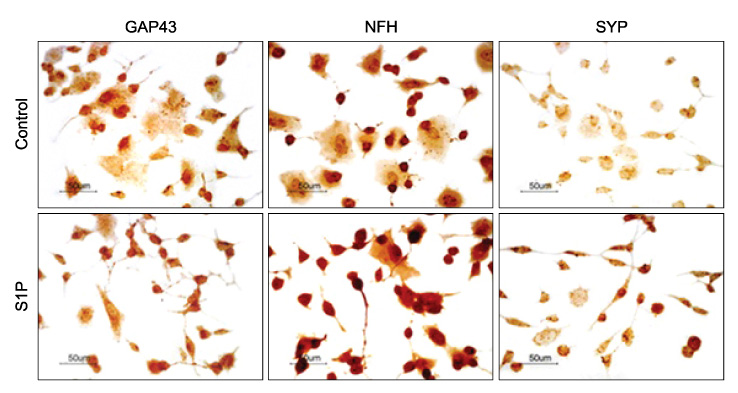Chonnam Med J.
2011 Apr;47(1):27-30. 10.4068/cmj.2011.47.1.27.
Effects of Sphingosine-1-Phosphate on Neural Differentiation and Neurite Outgrowth in Neuroblastoma Cells
- Affiliations
-
- 1Department of Physiology, Chonnam National University Medical School, Gwangju, Korea. parkjs@jnu.ac.kr
- 2Department of Pathology, Chonnam National University Medical School, Gwangju, Korea.
- KMID: 2172241
- DOI: http://doi.org/10.4068/cmj.2011.47.1.27
Abstract
- Sphingosine-1-phosphate (S1P) is emerging as a new class of second messenger involved in cellular proliferation, differentiation, and apoptosis and is implicated in diverse physiological functions. Despite many studies on the biological functions of S1P, however, little is known about its role in neuronal differentiation. By use of reverse transcription-polymerase chain reaction and immunostaining, this study aimed to explore whether S1P can differentiate neuroblastoma cells into neural cells. After incubation with 1 uM or 10 uM S1P, the number of neurite-bearing cells increased. Furthermore, the neuroblastoma cells revealed immunoreactivity for neural-specific markers such as GAP43, NFH, and SYP by immunostaining. The expression of NFH, MAP2, SYP, NeuroD1, and SYT mRNA, which is specific for neurons, was increased as shown by RT-PCR studies. The results of this study suggest that that S1P can induce neuronal differentiation and may be a good candidate for the treatment of neurodegenerative diseases.
MeSH Terms
Figure
Reference
-
1. Spiegel S, Milstien S. Sphingosine-1-phosphate: an enigmatic signalling lipid. Nat Rev Mol Cell Biol. 2003. 4:397–407.
Article2. Edsall LC, Pirianov GG, Spiegel S. Involvement of sphingosine 1-phosphate in nerve growth factor-mediated neuronal survival and differentiation. J Neurosci. 1997. 17:6952–6960.
Article3. Brinkmann V. Sphingosine 1-phosphate receptors in health and disease: mechanistic insights from gene deletion studies and reverse pharmacology. Pharmacol Ther. 2007. 115:84–105.
Article4. Choi JW, Lee CW, Chun J. Biological roles of lysophospholipid receptors revealed by genetic null mice: an update. Biochim Biophys Acta. 2008. 1781:531–539.
Article5. Riboni L, Prinetti A, Bassi R, Caminiti A, Tettamanti G. A mediator role of ceramide in the regulation of neuroblastoma Neuro2a cell differentiation. J Biol Chem. 1995. 270:26868–26875.
Article6. Rius RA, Edsall LC, Spiegel S. Activation of sphingosine kinase in pheochromocytoma PC12 neuronal cells in response to trophic factors. FEBS Lett. 1997. 417:173–176.
Article7. Miranda GE, Abrahan CE, Politi LE, Rotstein NP. Sphingosine-1-phosphate is a key regulator of proliferation and differentiation in retina photoreceptors. Invest Ophthalmol Vis Sci. 2009. 50:4416–4428.
Article8. Patterson PH. Control of cell fate in a vertebrate neurogenic lineage. Cell. 1990. 62:1035–1038.
Article9. Påhlman S, Odelstad L, Larsson E, Grotte G, Nilsson K. Phenotypic changes of human neuroblastoma cells in culture induced by 12-O-tetradecanoyl-phorbol-13-acetate. Int J Cancer. 1981. 28:583–589.
Article10. Labbaye C, Valtieri M, Barberi T, Meccia E, Masella B, Pelosi E, et al. Differential expression and functional role of GATA-2, NF-E2, and GATA-1 in normal adult hematopoiesis. J Clin Invest. 1995. 95:2346–2358.
Article11. Medlin MD, Staus DP, Dubash AD, Taylor JM, Mack CP. Sphingosine 1-phosphate receptor 2 signals through leukemia-associated RhoGEF (LARG), to promote smooth muscle cell differentiation. Arterioscler Thromb Vasc Biol. 2010. 30:1779–1786.
Article12. Meacci E, Nuti F, Donati C, Cencetti F, Farnararo M, Bruni P. Sphingosine kinase activity is required for myogenic differentiation of C2C12 myoblasts. J Cell Physiol. 2008. 214:210–220.
Article13. Rotstein NP, Miranda GE, Abrahan CE, German OL. Regulating survival and development in the retina: key roles for simple sphingolipids. J Lipid Res. 2010. 51:1247–1262.
Article14. Yuste VJ, Sánchez-López I, Solé C, Encinas M, Bayascas JR, Boix J, et al. The prevention of the staurosporine-induced apoptosis by Bcl-X(L), but not by Bcl-2 or caspase inhibitors, allows the extensive differentiation of human neuroblastoma cells. J Neurochem. 2002. 80:126–139.
Article15. López-Carballo G, Moreno L, Masiá S, Pérez P, Barettino D. Activation of the phosphatidylinositol 3-kinase/Akt signaling pathway by retinoic acid is required for neural differentiation of SH-SY5Y human neuroblastoma cells. J Biol Chem. 2002. 277:25297–25304.
Article16. Ronca F, Yee KS, Yu VC. Retinoic acid confers resistance to p53-dependent apoptosis in SH-SY5Y neuroblastoma cells by modulating nuclear import of p53. J Biol Chem. 1999. 274:18128–18134.
Article
- Full Text Links
- Actions
-
Cited
- CITED
-
- Close
- Share
- Similar articles
-
- Reactive Oxygen Species are Involved in Y-27632-induced Neurite Outgrowth in PC12 Cells
- Overexpression of neurogenin1 induces neurite outgrowth in F11 neuroblastoma cells
- Phosphatidylinositol 4-phosphate 5-kinase alpha negatively regulates nerve growth factor-induced neurite outgrowth in PC12 cells
- Inhibition of Neurite Outgrowth by Overexpression of Goa
- p190RhoGAP and Rap-dependent RhoGAP (ARAP3) inactivate RhoA in response to nerve growth factor leading to neurite outgrowth from PC12 cells




